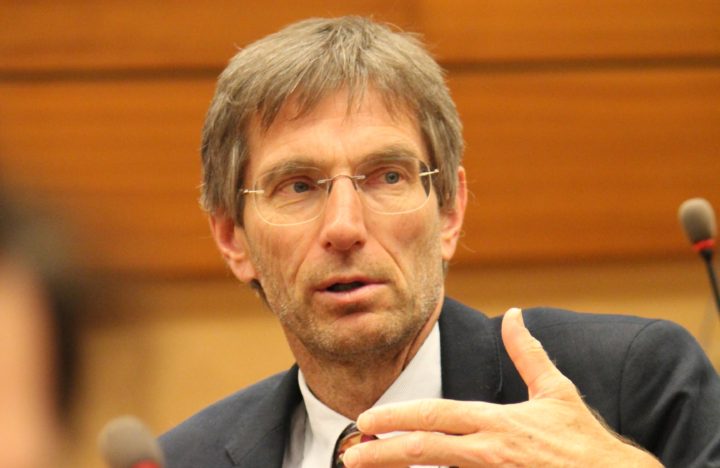Co-president Tilman Ruff addressed the Open-Ended Working Group on nuclear weapons on May 13 in Geneva, on behalf of IPPNW’s Australian affiliate, MAPW, and ICAN. His remarks follow:
Given some views expressed here in recent days, I feel a medical responsibility to highlight for representatives in this room some crucial evidence on the weapons under discussion.
Public policy should be based on evidence—especially in relation to the most acute existential threat that has ever lain in human hands. The inescapable implications of established evidence should be drawn and acted upon. Yet some of the discussion here has demonstrated that some crucial evidence has yet to be widely understood.
I noted last week that the more we know about what nuclear weapons do, the worse it looks.
The evidence from climate and agricultural science, discussed by Dr. Helfand in the panel on humanitarian consequences, has profound implications.
The concept of “minimization” at levels of 2,000 weapons between Russia and the US—in addition to 1,000 weapons owned by the other nuclear armed states—as some kind of safe resting place, even if interim, has scant basis in evidence.
Reduction in numbers of nuclear weapons from 70,000 to 15,400, and reduction of their explosive yield to a median of 200 kt, has not proportionately reduced the existential risk; so huge is the level of “redundant destruction” embodied in nuclear arsenals.
Fires ignited by nuclear explosions over urban and industrial centers release many times more energy than the explosive yield of the bombs themselves.
The destructive effects of nuclear weapons are not linearly related to their explosive yield. So-called low-yield weapons, with yields in the tens to hundreds of kilotons range, targetted at cities, are 100 times more efficient per kiloton at causing fatalities and in producing smoke than high-yield weapons.
The scenario presented by Dr. Helfand last week for a regional nuclear war between India and Pakistan used 100 Hiroshima size weapons—fewer than half the 220 nuclear weapons those two states currently possess.
These 100 weapons would constitute less than 0.5% of the nuclear weapons in the world, and less than 0.1% of their explosive yield. More than five million tons of sooty black smoke would be injected high into the atmosphere.
The subsequent global cooling, darkening and drying over decades, is conservatively estimated to put two billion people in jeopardy from starvation.
This is without factoring in markedly increased ultraviolet radiation and disruption of agricultural inputs—seed, fertiliser, pesticides, fuel and transport—that would inevitably follow a nuclear war.
Nor does this estimate include the epidemics of infectious disease that inevitably accompany famines, nor conflict within and between countries over dwindling food supplies.
Declines in food production following such a relatively small regional nuclear war would be greatest at higher latitudes. The nuclear-dependent states in this room who support the “progressive” business-as-usual approach all lie predominantly at mid and high latitudes. They would be among the countries experiencing the greatest declines in their major food crops. In higher latitudes, such as in northern Europe, food production would virtually cease.
Suddenly injecting five million tons of smoke into the upper atmosphere would very likely end human civilization.
Up to 144 nuclear warheads can be carried by one US Ohio class submarine, each 6-30 times the size of the Hiroshima bomb. Even at the low end of their yield, if targeted on Chinese cities, the warheads on one submarine would produce 23 million tons of smoke. The US has 14 such submarines, Russia a similar number. Each of them is a global climate catastrophe waiting to happen.
With the arsenals that Russia and the US would have left next year after the New START treaty is fully implemented, a nuclear war would produce about 150 million tons of smoke.
1,000 nuclear weapons, advocated by some as a “minimization point,” would produce 85 million tons of smoke.
The risk of climate catastrophe and global famine will not be materially diminished by nuclear arsenals of 1,000 nuclear weapons, nor removed with arsenals of hundreds. Not only the arsenals of Russia and the US jeopardize the biosphere; six smaller arsenals each containing hundreds of weapons also risk global nuclear famine.
The evidence unequivocally demonstrates that in order to no longer pose a global threat to all humanity, nuclear weapons numbers would need to be reduced not to a few thousand or to hundreds, but to tens. The imperative for zero and its urgency are inescapable.
Finally, I remind you that on the basis of the evidence, doctors, nurses and public health professionals worldwide have united for the first time in recommending to this OEWG that the only way to prevent the use of nuclear weapons is to ban and eliminate them, and that a new treaty banning nuclear weapons is the best and most feasible step that can be taken now towards their eradication.










